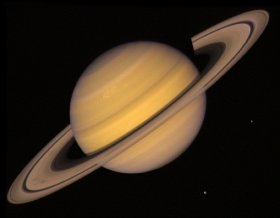SATurN


SATURN
Saturn is the second largest planet. Only Jupiter is larger. Saturn has seven thin, flat rings around it. The rings consist of numerous narrow ringlets, which are made up of ice particles that travel around the planet. The gleaming rings make Saturn one of the most beautiful objects in the solar system. Jupiter, Neptune, and Uranus are the only other planets known to have rings. Their rings are much fainter than those around Saturn.
Saturn's diameter at its equator is about 74,900 miles (120,540 kilometers), almost 10 times that of Earth. The planet can be seen from Earth with the unaided eye, but its rings cannot. Saturn was the farthest planet from Earth that the ancient astronomers knew about. They named it for the Roman god of agriculture.
Rotation
As Saturn travels around the sun, it spins on its axis, an imaginary line drawn through its center. Saturn's axis is not perpendicular (at an angle of 90 degrees) to the planet's path around the sun. The axis tilts at an angle of about 27 degrees from the perpendicular position.
Surface and atmosphere
Most scientists believe Saturn is a giant ball of gas that has no solid surface. However, the planet seems to have a hot solid inner core of iron and rocky material. Around this dense central part is an outer core that probably consists of ammonia, methane, and water. A layer of highly compressed, liquid metallic hydrogen surrounds the outer core. Above this layer lies a region composed of hydrogen and helium in a viscous (syruplike) form. The hydrogen and helium become gaseous near the planet's surface and merge with its atmosphere, which consists chiefly of the same two elements.
Temperature
The tilt of Saturn's axis causes the sun to heat the planet's northern and southern halves unequally, resulting in seasons and temperature changes. Each season lasts about 7 1/2 Earth years, because Saturn takes about 29 times as long to go around the sun as Earth does. Saturn's temperature is always much colder than Earth's, because Saturn is so far from the sun. The temperature at the top of Saturn's clouds averages -285 degrees F (-175 degrees C).
Density and mass
Saturn has a lower density than any other planet. It is only about one-tenth as dense as Earth, and about two-thirds as dense as water. That is, a portion of Saturn would weigh much less than an equal portion of Earth, and would float in water.
Although Saturn has a low density, it has a greater mass than any other planet except Jupiter. Saturn is about 95 times as massive as Earth. The force of gravity is a little higher on Saturn than on Earth. A 100-pound object on Earth would weigh about 107 pounds on Saturn.
Rings
The rings of Saturn surround the planet at its equator. They do not touch Saturn. As Saturn orbits the sun, the rings always tilt at the same angle as the equator.
The seven rings of Saturn consist of thousands of narrow ringlets. The ringlets are made up of billions of pieces of ice. These pieces range from ice particles that are the size of dust to chunks of ice that measure more than 10 feet (3 meters) in diameter.
Satellites
In addition to its rings, Saturn has 25 satellites that measure at least 6 miles (10 kilometers) in diameter, and several smaller satellites. The largest of Saturn's satellites, Titan, has a diameter of about 3,200 miles (5,150 kilometers) -- larger than the planets Mercury and Pluto. Titan is one of the few satellites in the solar system known to have an atmosphere. Its atmosphere consists largely of nitrogen.
Flights to Saturn
In 1973, the United States launched a space probe to study both Saturn and Jupiter. This craft, called Pioneer-Saturn, sped by Jupiter in 1974 and flew within 13,000 miles (20,900 kilometers) of Saturn on Sept. 1, 1979. The probe sent back scientific data and close-up photographs of Saturn. The data and photographs led to the discovery of two of the planet's outer rings.


























